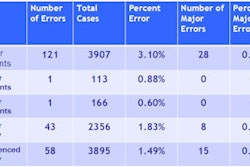The devil is in the details. That could be said about the failed merger between the American College of Radiology (ACR) and the American Roentgen Ray Society (ARRS): the two radiology groups called off their strategic integration after they were unable to resolve issues regarding the ACR's continuing medical education (CME) business.
The outcome of the unsuccessful merger was seen October 19 at the ACR headquarters in Reston, VA. Moving vans rolled away with the boxed files, office furniture, and computers from the administrative operations of the ARRS. Unpacking began later the same day 20 miles away in Leesburg, VA, where nine staff members moved back into the same office building, owned by the ARRS, that it left in August 2009 at the start of strategic integration with the ACR. The rest of the staff will move back to Leesburg by the end of the year.
Disappointment ... but relief
The agreement was dissolved September 29 with a unanimous vote of the ARRS executive council. In interviews, ACR and ARRS leaders expressed disappointment about the annulment, but relief at the amicable way the two organizations were separated.
"Once we realized the merge was not meeting the needs of either organization, the leadership had the maturity and trust in one another to unwind it in a fashion that good feeling remain between the organizations," said James Thrall, MD, former chairman of the ACR's Board of Chancellors.
James Brink, MD, president-elect of ARRS, characterized the actions as a positive step for both societies.
"Without the strategic alliance, the opportunity to collaborate will perhaps be even greater than with the constraints we felt from the strategic integration merger agreement that we operated under previously," he said.
The consolidation was designed to reduce costs and sharpen strategic focus from the two merged societies. The ACR and ARRS merged operationally, but legally each retained their separate 501(c)3 nonprofit corporate status. Their governing bodies were reconfigured, allowing each society to influence policymaking for the other group. In addition, the public identities of the ACR and ARRS were preserved by maintaining separate professional staffs, missions, memberships, and programs.
The merger weakened when it became clear that the ACR could not deliver on its promise to consolidate its CME programs under the exclusive control of the ARRS, Thrall said. The ACR relinquished its Accreditation Council for Continuing Medical Education (ACCME) accreditation in May, and the responsibility for the successful ACR Educational Center was turned over to the ARRS. But the ACR found many of its educational activities could not be easily extracted from various commissions.
"They are linked almost like Siamese twins, so there was no practical way of separating the educational activities of the Commission on Economics, for example, from its other work," Thrall said.
No single event led the ARRS to walk away, Brink noted, but the rationale for combining interests was lost when the ACR reached an impasse on the education issue.
Little impact on membership
Though the merger was short-lived, it reaped financial benefits that helped both societies weather the recession, Thrall said. Lower staffing costs offset lost revenue from declining advertising sales and memberships.
Members were largely unaffected by the merger, Brink said. The rolls were never consolidated, and annual dues were never altered. Because of the breakup, ARRS will again only accredit its CME activities. The ACR will be the accredited body for its CME activities..
Because of the breakup, the overlapping governing structures for the two societies will be modified. Five seats on the ACR Board of Chancellors that had been reserved for ARRS representatives will be cut back to the two seats that they held before the merger. Two new seats on the ARRS executive council set aside for ACR representatives will be eliminated.
Thrall, who also led an unsuccessful attempt to combine the two societies in 2004, believes the issue will be revisited.
"I still think it is desirable," he said. "There is unnecessary duplication among the 55 organizations that represent the radiological profession. Economics are going to favor merger."
Society leaders are examining how lessons from the current failed effort can aid future initiatives. Their initial reading of the experience suggests detailed planning on how to execute a merger is needed to successfully pull it off.
"Despite all the time we worked on it, we never got to that level of detail," he said.
By James Brice
AuntMinnie.com contributing writer
October 25, 2010
Related Reading
ACR, ARRS to restructure alliance, October 1, 2010
Spanish rad society joins ARRS global program, June 23, 2010
ACR, ARRS wrap up integration deal, May 5, 2009
ARRS membership approves ACR integration, April 30, 2009
ACR, ARRS to join forces, February 6, 2009
Copyright © 2010 AuntMinnie.com


















